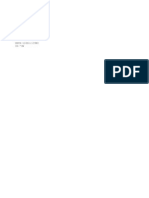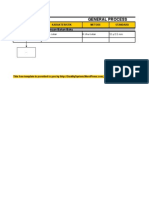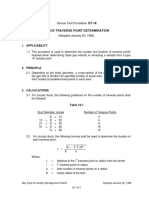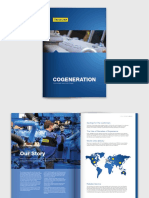Technical Manual Rotary Valve
Technical Manual Rotary Valve
Uploaded by
xichengrenCopyright:
Available Formats
Technical Manual Rotary Valve
Technical Manual Rotary Valve
Uploaded by
xichengrenOriginal Description:
Copyright
Available Formats
Share this document
Did you find this document useful?
Is this content inappropriate?
Copyright:
Available Formats
Technical Manual Rotary Valve
Technical Manual Rotary Valve
Uploaded by
xichengrenCopyright:
Available Formats
Technical Manual on Installation, Operation & Maintenance
Rotary Valve
ISO 9001:2000
VENTEC AMBIENTAL EQUIPAMENTOS E INSTALAES LTDA
Rua Andr Adolfo Ferrari, n 550 - Distrito Industrial Nova Era - Indaiatuba - So Paulo
CEP: 13.347.395 - C.Postal: 2086 - Fone: (19) 3801-8800 / Fax: (19) 3935-6906
e-mail: ventec@ventec.com.br - site: www.ventec.com.br
Rotary valve
ISO 9001:2000
INDEX
1 INTRODUCTION .................................................................................................................................................. 03
2 GENERAL CONCEPTS ........................................................................................................................................ 03
3 ASSEMBLING
3.1 Rotary valve assembly.......................................................................................................................... 03
3.2 Valve assembling on equipment ........................................................................................................... 03
4 OPERATION
4.1 Checks before operation starting .......................................................................................................... 04
4.2 Checks during operation ....................................................................................................................... 04
5 MAINTENANCE
5.1 Body and rotor ...................................................................................................................................... 04
5.2 Actuation ............................................................................................................................................... 05
5.3 Vibration ................................................................................................................................................ 05
5.4 Bearing Lubrication .............................................................................................................................. 05
5.4.1 Greasing ................................................................................................................................. 05
5.4.2 Lubrication Interval .................................................................................................................. 05
5.5 Reducer ............................................................................................................................................... 06
5.5.1 - Motor ........................................................................................................................................ 07
5.6 Repainting ............................................................................................................................................. 08
5.7 List of spare parts for 2 years operation .............................................................................................. 08
Page: 2/8
Rev.: 1 15/09/2008
Rotary valve
ISO 9001:2000
1 INTRODUCTION
The recommendations provided in this manual have been prepared based on the data of the project involved and
experimental laboratory know-how that made it possible to apply the products supplied.
However, the user has additional information about hands-on operating conditions and about the workplace.
Therefore, the user can join this know-how to the hands-on recommendations in this guide, information and more
specific details on each component supplied by the manufacturer and prepare a good installation and operation
scheme and a safe maintenance program.
Several data sheets specific to the sets and to key accessories are part of this Manual. They indicate the most
relevant technical and construction characteristics.
Besides the recommendations in this manual, which must be considered as supplementary, we recommend not
leaving aside the usual norms relating to good operation, maintenance and installation techniques.
It must be pointed out that the use of qualified personnel, both in operation and in maintenance of the equipment
means eliminating countless problems.
2 GENERAL CONCEPTS
A Rotary valve is robust-construction equipment designed to unload particulate or granulated material.
The material to be unloaded enters the valve body and is driven by a rotor to the outlet mouthpiece in a cyclic and
continuous movement, thus providing a regular flow of material with maximum filling degree around 30%.
The rotor / axle set is actuated by the gear set.
3 ASSEMBLY
3.1 Assembly of the Rotary valve
a)
b)
c)
d)
e)
Assemble sealing rubbers to rotor.
Assemble the rotor / axle set on body.
Fix side caps with sealing gaskets and with the ROLMAX bearing
Align the entire set to go on with the assembly.
Assemble the pulleys (driving and driven) with IMETEX fixing ring when valve construction requires this type
of driving.
f) Assemble and align the reducer / pulley and belts on valve, when required.
g) Check if all components are fixed and aligned (Rotor/axle/bearings gear, etc)
h) Complete reducer oil level.
3.2 Assembling the valve on equipment
The Rotary valve can be connected to other equipment the following way: the valve inlet and outlet have flanges
where the valve can be connected to counter-flanges of other equipment by bolts.
Sealing compound must be applied between flanges to ensure perfect adjustment between flanges.
Page: 3/8
Rev.: 1 15/09/2008
ISO 9001:2000
Rotary valve
4 OPERATION
4.1 Checks before starting operation
Before shipment, the construction and finishing of all units of equipment is visually controlled. They are tested in
operation to observe the work of all parts and accessories involved in manufacturing and assembly.
However, there is the risk of some damage in transportation. For this reason, the unit should be inspected by the
customer upon arrival and any irregularities should be reported to the manufacturer. We also recommend the
following procedures before starting operations:
a)
b)
c)
d)
e)
f)
Be sure that protections and accessories (when applicable) are duly tightened and installed.
Check tightness of assembling bolts of modules, motor fixing, reducers etc.
Check bearing lubrication and right level of reducer.
Be sure that there are no bolts, nuts or foreign parts inside body valve.
Check rotation direction (in case of flexible sealing edge)
Check alignment of the motor, reducer, pulleys and belts when applicable.
4.2 Check when starting operation
After starting valve operation, the following procedure is recommended:
a)
b)
c)
d)
e)
f)
Check lubrication condition.
Make sure there is no noise or abnormal vibrations in rotating parts.
Check if there are any loose bolts or poorly tightened in the set.
Check general condition of seals between flanges.
Follow up temperature of bearings periodically: after the equipment reaches normal operating conditions, the
temperature cannot exceed 80 C.
Check general wear of the set; particularly wear of sealing elements of the rotor.
5 MAINTENANCE
5.1 Rotor and Body
-
The inlet mouthpiece must be tightly sealed. Any leaks should be fixed immediately.
External painting must be renewed whenever possible, or according to possibilities, to avoid part corrosion.
The Rotary valve must be continuously observed: make sure there is no dust build-up. If there is any dust, the
blades must be cleaned carefully with:
- Steam,
- Water jet,
- Compressed air, or
- Metal brush.
Under no circumstances cleaning should be mad by hitting on the valve body or rotor with heavy parts. Such
procedure will cause deformations and leaks.
These deformations will favour build-up or agglomeration of materials, which will cause increased resistance
besides reducing the volume of dust to be unloaded.
In case of wear of blades, of rotor, or of sealing elements, these should be replaced periodically.
Page: 4/8
Rev.: 1 15/09/2008
Rotary valve
ISO 9001:2000
5.2 Start-up
Check the motor, reducer, fixing ring and bearings periodically.
5.3 Vibration
Check if there are excess vibrations on supports, as well as on starting-up parts, to prevent premature wear of the
equipment.
5.4 Bearing lubrication
Bearings: Bearings are lubricated when assembled at VENTEC factory; however they should be checked before
putting into operation. The specifications for a normal lubrication can be found in the following items.
Bearings: Clean bearings, eliminating all dirt and impurities before lubricating them. This can be done by washing
them with a clean petroleum solvent, and then drying them carefully with air or a clean cloth.
5.4.1 - Greasing:
-
Only good quality grease should be used, free from chemical and mechanical agents to lubricate the roller
bearings or rollers. To obtain a good result use the same grease to re-lubricate.
Bearings
(Suppliers)
FAFNIR
SKF
Bearing type
American Grease
Lak, Rak, LCJ,
RCJ, LCJO RCJO Shell Alvania - 3
LSAO, RSAO
SAOL
Mobil Mobilux - 2
SYR, FYR
Shell Alvania - 2
SY, FY
Shell Alvania - 3
SAF-22500
SAF 2260
SAF 1500
Mobil Mobilux- 2
SAF 22200
SAF 22300
Grease Base
Lithium
Similar
(Domestic)
Shell Alvania 3
Lithium
Lithium
Lithium
Mobil Grease MP
Shell Alvania - 2
Shell Alvania - 3
Lithium
Mobil Grease MP
We do not recommend mixing different lubricants: If it is necessary to change to another brand, quality or
different type of lubricant, clean the bearings thoroughly.
The change of grease depends on the number of operating hours, temperature conditions and environment,
varying from 3 months to 1 year.
5.4.2 - Lubrication periodicity:
-
It is difficult to set re-lubrication frequency to avoid corrosion and to help eliminate any solid or liquid impurities
as a fixed norm, because it can vary a lot with the different types of applications. The ideal thing would be to
obtain the re-lubrication frequency using an experimental program for its components or particular type, or
else obtain this value via field verification.
The experimental phase can be followed by bearing re-lubrication in pre-established intervals, observing the
condition of the grease that comes out of the seals; or periodical inspection on body. If the operation
environment is clean and bearings work at normal ambient temperature, they can be lubricated every 3, 4 or
up to 6 months field they work satisfactorily. On the other hand, if the bearings are exposed to polluted and
dirty conditions under high temperatures, this will force lubrication in more frequent intervals. Guidance for
operation is determined as follows:
:
Page: 5/8
Rev.: 1 15/09/2008
Rotary valve
ISO 9001:2000
DUST CONDITIONS
Regularly Cleaned
No
Moderate
to
extremely dirty.
No
Regularly clean
OPERATING IN
HUMIDITY
High humidity up to
use water jet.
TEMPERATURE
BEARING
OPERATION
0 to 49 C
49 to 71 C
71 to 93 C
From 6 to 12 months
From 1 to 12 months
From 1 to 4 weeks
0 to
71 to
71 C
93 C
From 1 to 4 weeks
(Max.) 1 week.
93 C
(Max) 1 week.
to
LUBRICATION
PERIODICITY
When adding grease, avoid penetration of any impurities inside the bearing.
During the first period of operation, the bearing should be open to allow excess grease to come out (the
grease will be expelled automatically). Afterwards replace outlet plug and use a gun to lubricate with low
pressure grease.
IMPORTANT: Never lubricate bearings excessively.
5.5 Reducer
Before being shipped, all reducers used in the Ventec equipment are submitted to a working test without load.
Under normal transport and storage conditions, the lubrication used ensures protection during assembly.
When the equipment is assembled, provide for free access to reducer, particularly to the inspection plug and to the
level of lubrication, as well as to the draining plug. The air flow to dissipate heat from the reducer must not be
blocked by protection devices or others.
The couplings have been duly assembled at our factory according to guidance from the respective manufacturers.
Before start-up, it is the duty of the customer to check for misalignments during transport and assembly, and to
secure these elements so there is no axial displacement, when in operation.
a) Check before starting:
-
Fixing and instructions above described,
Supply of new lubricant (see suitable viscosity and lubricant type shown on reducer identification plate).
Check level with reducer stopped according to indicated quantity.
Start operating without load for some hours. Such procedure provides improved quality of gear surface and
prolongs service life of reducer.
If no anomalies are detected, operation can start at full load. Otherwise consult procedures in this manual or
call Ventec or reducer manufacturer.
Check temperature. In general, oil temperatures up to 80 C do not affect reducer operation. In certain cases,
higher temperatures can be foreseen. See the manufacturer/type of lubricant.
Reducers stopped for more than 3 months should get new service.
b) Lubrication / Maintenance:
-
The reducers need minimum maintenance. It is limited to regular lubricant control and replacement.
Periodicity of change depends on the type of oil and operating temperature (check with lubricant
manufacturer). In case it has few hours of daily use, it is recommended to change:
Mineral lubricants (CLP, HLP types), after 3 years maximum.
Synthetic lubricants (PAO, PG), after 5 years maximum.
Never mix mineral with synthetic lubricants.
Page: 6/8
Rev.: 1 15/09/2008
Rotary valve
ISO 9001:2000
5.5.1 Motor
a) Lubrication:
-
Motors with up to body 160 do not have grease nipples, whereas for motors with body 160 up to body 200, the
nipple grease is optional. Above this body (225 to 355), it is normal to have nipple grease. The purpose of
maintenance, in this case, is to increase service life of the bearing system as much as possible.
Maintenance includes:
a) Observation of general condition of bearings,
b) Lubrication and cleaning,
c) Careful bearing exam.
Temperature control of a bearing is also part of routine maintenance, if the bearing is lubricated with
appropriate grease, as recommended in item (Quality and quantity of grease) work temperature should not
exceed 70 C.
Bearings should be lubricated to avoid the metal contact between rolling parts and also to protect them against
corrosion and wear.
Lubricant properties deteriorate due to age and mechanical work. Moreover, all lubricants get contamination in
service; that is why they should be levelled or changed periodically.
b) Lubricant periodicity:
-
The correct amount of grease is, with no doubt, an important aspect for good lubrication.
Re-lubrication must be made according to Lubricant Periodicity chart; however if the motor has an additional
plate with lubricant instructions, these should be followed according to plate specifications.
For an efficient initial lubrication, it is necessary to consult motor instruction manual or Lubrication chart of the
bearing. If this information is not available, the bearing must be filled with grease up to half of its empty space
(only free space between Rotary bodies).
When doing these operations, it is recommended the maximum of care and cleaning, with the purpose to
avoid any dirt penetration that can cause damage to the bearing.
c) Quality and quantity of grease:
-
It is important to make a correct lubrication, i.e., apply the correct grease and in a suitable quantity, because
both deficient lubrication and excess lubrication cause faults.
Excess lubrication will cause temperature to rise due to the great resistance that it causes to movement of
rotating parts. It ends up by losing its lubricating characteristics completely. This can cause leaks, and grease
penetrates inside motor and deposits the coils or other motor parts.
To lubricate bearings in electrical machines, lithium-based grease has been used in a generalized way,
because it has mechanical stability and is insoluble in water.
The grease must never be mixed with others that have a different base.
d) Grease to be used in normal motors:
TYPE
Unirex
Alvania R3
MANUFACTURER
Esso
Shell.
MODEL
225 s/m to 355 m/l
Other bodies.
e) Grease to be used in motors with special characteristics:
TYPE
STABURAGS N12MF
CENTOPLEX 2 dl
MILYKOTE TTF 52
MOBILTEMP SHC 32
DOW CORNING 44
ISOFLEX NBU 15
STABURAGS NBU 12
UNISILKON L 50/2
TEMPERATURE ( C)
( - 35 to 150 )
( - 55 to 80 )
( - 52 to 100 )
( - 54 to 177 )
( - 40 to 200 )
( - 30 to 130 )
( - 35 to 150 )
( - 50 to 200 )
Page: 7/8
Rev.: 1 15/09/2008
ISO 9001:2000
Rotary valve
f) Instructions for lubrication:
-
Inject approximately half of total quantity of estimated grease and start motor. Turn it for approximately 1
minute full rotation, then turn off motor and put the rest of the grease.
Injection of all grease with motor off can lead to penetration of lubricant inside the motor.
It is important to maintain grease fittings clean before introducing grease to prevent foreign material into
bearing.
Important: For Lubrication use only manual grease gun.
g) Lubrication steps for bearings:
-
Clean with cotton cloth near the fitting grease holes.
With motor working, add grease using a gun for fitting grease until the recommended amount of grease is
introduced.
Leave the motor running enough time to drain all excess grease.
5.6 Repainting
Repainting internal and external parts of Rotary valve will increase its durability. Choose paintings that resist
operation temperatures; for normal temperatures, use a good paint for machines. If there is excessive humidity, or
if transporters are exposed to bad weather, bituminous paints are recommended.
The competent person or sector must be warned when there are corrosive gases.
5.7 List of spare parts for 2 years operation
-
1 axle
2 bearings
2 bearings
1 elastic coupling
Note: See technical data on set drawing.
Page: 8/8
Rev.: 1 15/09/2008
You might also like
- VM 2.5 ManualDocument49 pagesVM 2.5 Manualjeepfreak212185% (20)
- Hibon Tri Lobe Blower Manual PDFDocument55 pagesHibon Tri Lobe Blower Manual PDFtayyabeme100% (1)
- Co2 CaptureDocument17 pagesCo2 CaptureRinoy BhuvanrajNo ratings yet
- Bobcat 753 Service ManualDocument502 pagesBobcat 753 Service ManualOsama Farah71% (7)
- 2013-12-01 Press Release Directory Copper Mines PlantsDocument163 pages2013-12-01 Press Release Directory Copper Mines PlantsxichengrenNo ratings yet
- Wet Scrubber Selection GuideDocument8 pagesWet Scrubber Selection GuideHESuarez100% (2)
- Wind Turbine FormulasDocument5 pagesWind Turbine FormulasSamer Al-Mimar100% (1)
- Bio102 Assignment 6Document3 pagesBio102 Assignment 6Daniel50% (2)
- Mechanical IOCL Technical PYQsDocument19 pagesMechanical IOCL Technical PYQsSANDIP PATELNo ratings yet
- The Effects of Rotary Kiln Operating Conditions and Design On Burden Heating Rates As Determined by A Mathematical Model of Rotary Kiln Heat Transfer PDFDocument9 pagesThe Effects of Rotary Kiln Operating Conditions and Design On Burden Heating Rates As Determined by A Mathematical Model of Rotary Kiln Heat Transfer PDFSHRAVAN KUMARNo ratings yet
- Refractories T1 TheoryDocument12 pagesRefractories T1 TheoryslchemNo ratings yet
- Quality Plan TemplateDocument2 pagesQuality Plan Templateapi-3850616100% (3)
- Recausticizing TestDocument4 pagesRecausticizing Testseto_19100% (1)
- RABH-sugest by SatputeDocument1 pageRABH-sugest by Satputegvrr1954No ratings yet
- Nicored 182 PDFDocument1 pageNicored 182 PDFDương Quang KhánhNo ratings yet
- 1 Gypsum CalcinationDocument6 pages1 Gypsum CalcinationisdsdksjdksjNo ratings yet
- Better Grinding Systems: Figure 1: DeglomeratorDocument5 pagesBetter Grinding Systems: Figure 1: DeglomeratorGerman Gabriel Anaya VegaNo ratings yet
- Traverse Point For MeasurementDocument2 pagesTraverse Point For MeasurementsudheerNo ratings yet
- Third Generation Separators - Part 2Document2 pagesThird Generation Separators - Part 21qwerNo ratings yet
- 327 - IBAU Silo-Das Original PDFDocument28 pages327 - IBAU Silo-Das Original PDFtaghdirimNo ratings yet
- H/mo #NAME?: Production Clinker Monthly / MoDocument3 pagesH/mo #NAME?: Production Clinker Monthly / MoElwathig BakhietNo ratings yet
- Literature ReviewDocument6 pagesLiterature ReviewIrfan FadzailahNo ratings yet
- Steps Involved in Kiln AuditDocument1 pageSteps Involved in Kiln AuditVijay BhanNo ratings yet
- V P P P: Alid Ractice Roduction RocessDocument3 pagesV P P P: Alid Ractice Roduction RocessMin MCLNo ratings yet
- Rajdhani Scientific Co Bomb Calorimeter Model RSB-5 Instruction ManualDocument5 pagesRajdhani Scientific Co Bomb Calorimeter Model RSB-5 Instruction ManualPartha Goswami100% (1)
- Coal Miners SuitDocument4 pagesCoal Miners SuitSudipta BainNo ratings yet
- Internship ReportDocument10 pagesInternship ReportAhmad HassanNo ratings yet
- Innovations in Portland Cement Manufacturing: Edited byDocument1 pageInnovations in Portland Cement Manufacturing: Edited byAhmed YounisNo ratings yet
- OCL Bengal Cement WorksDocument35 pagesOCL Bengal Cement WorksswarupkumarnayakNo ratings yet
- ResumeDocument3 pagesResumeHari Prathap ReddyNo ratings yet
- Department:Production: Cement Mill Process Control and OperationDocument6 pagesDepartment:Production: Cement Mill Process Control and OperationZegera MgendiNo ratings yet
- Comparative Analysis of Chemical and Physical Properties of Mini Cement Plant and Major Cement PlantDocument3 pagesComparative Analysis of Chemical and Physical Properties of Mini Cement Plant and Major Cement PlantJournal 4 ResearchNo ratings yet
- 22 Vertical Mills: Rs 78 Power Consumption and Sizing of Vertical MillsDocument3 pages22 Vertical Mills: Rs 78 Power Consumption and Sizing of Vertical Millszane truesdaleNo ratings yet
- Ball-Cement-Mill-Monitoring-Inspection-Evaluation Chapter 1Document8 pagesBall-Cement-Mill-Monitoring-Inspection-Evaluation Chapter 1Min MCLNo ratings yet
- RPM Kiln Vs FDDocument2 pagesRPM Kiln Vs FDTIRIANTO100% (1)
- In Line Shredder: Keep Your CarrierDocument2 pagesIn Line Shredder: Keep Your CarrierOmar Ahmed ElkhalilNo ratings yet
- Mathematical ModelDocument26 pagesMathematical Modeloscop2009No ratings yet
- Description of Raw Meal BlendingDocument9 pagesDescription of Raw Meal BlendingJoseph Novilla100% (1)
- NO - Theory: (Types of )Document22 pagesNO - Theory: (Types of )Dipesh LakhotiaNo ratings yet
- Gujarat Sidhee Cement Limited-SmitDocument26 pagesGujarat Sidhee Cement Limited-SmitHimadri MahatoNo ratings yet
- Air SeperatorDocument45 pagesAir Seperatorsameh ibrahemNo ratings yet
- Thermos Design of Rotary Kiln For Reduction of Radiation Losses-10Document17 pagesThermos Design of Rotary Kiln For Reduction of Radiation Losses-10Madhav Krishna MNo ratings yet
- Long Filter BagDocument1 pageLong Filter BagAlbar BudimanNo ratings yet
- Per Banding An Desain Fls Pfister FeederDocument5 pagesPer Banding An Desain Fls Pfister Feederde_chemenx2540No ratings yet
- Grindability of Commercial Clinkers With High MgO LevelDocument7 pagesGrindability of Commercial Clinkers With High MgO LevelAnonymous NxpnI6jCNo ratings yet
- Pre Commissioning Checks in Pyro - Pre Heater AreaDocument1 pagePre Commissioning Checks in Pyro - Pre Heater AreaVijay BhanNo ratings yet
- Hutul Cement Company Case StudyDocument4 pagesHutul Cement Company Case StudyShakil AhmedNo ratings yet
- Christian Pfeiffer Foreign Matter TrapDocument1 pageChristian Pfeiffer Foreign Matter TrapMohamedNo ratings yet
- Performance Evaluation of Vertical Roller Mill in Cement Grinding: Case Study ESCH Cement PlantDocument8 pagesPerformance Evaluation of Vertical Roller Mill in Cement Grinding: Case Study ESCH Cement PlantSohail AhmedNo ratings yet
- Chimestry Mechanical Engineering: Group No # 2 REG NO # 16 To 36 Lets StartDocument44 pagesChimestry Mechanical Engineering: Group No # 2 REG NO # 16 To 36 Lets StartarslanNo ratings yet
- Crude Oil Charecteristics For Various CrudesDocument14 pagesCrude Oil Charecteristics For Various CrudesImran Shaikh100% (1)
- Cement Maintenance Ms WordDocument6 pagesCement Maintenance Ms Wordsharif339No ratings yet
- SOP - Startup Shutdown and Operation of Coal MillDocument2 pagesSOP - Startup Shutdown and Operation of Coal MillJCSNo ratings yet
- Book 6 Cement KilnsDocument24 pagesBook 6 Cement KilnsPrabakaran BaskaranNo ratings yet
- Bottle Role TestDocument12 pagesBottle Role TestcemsavantNo ratings yet
- Energy ManagementDocument9 pagesEnergy Managementhasan_jafri_2No ratings yet
- NCV CalculationDocument4 pagesNCV CalculationNaveed Ul Qamar Mughal100% (1)
- ETA Cooler 0204Document8 pagesETA Cooler 0204Elwathig BakhietNo ratings yet
- Sugar Factory InsulationDocument29 pagesSugar Factory InsulationZerihun Negash100% (1)
- Dust Explosion in CFBC BoilersDocument5 pagesDust Explosion in CFBC BoilersS V NAGESHNo ratings yet
- 35-Castables With MgO-SiO2-Al2O3 As Bond PhaseDocument11 pages35-Castables With MgO-SiO2-Al2O3 As Bond PhaseAnky FadharaniNo ratings yet
- Rotary Valve Selector Guide PDFDocument28 pagesRotary Valve Selector Guide PDFtradehouseNo ratings yet
- Rotary Valves MaintenanceDocument8 pagesRotary Valves MaintenanceAbdelkhak KhallaNo ratings yet
- Rotary Valve FabricatedDocument11 pagesRotary Valve FabricatedAdem AltanNo ratings yet
- Torqueflite A-727 Transmission Handbook HP1399: How to Rebuild or Modify Chrysler's A-727 Torqueflite for All ApplicationsFrom EverandTorqueflite A-727 Transmission Handbook HP1399: How to Rebuild or Modify Chrysler's A-727 Torqueflite for All ApplicationsNo ratings yet
- Copper 2010 Vol 1-7Document56 pagesCopper 2010 Vol 1-7xichengren100% (1)
- 2016 10 17 ICSG Factbook 2016 PDFDocument64 pages2016 10 17 ICSG Factbook 2016 PDFxichengren100% (1)
- Technical Manual Centrifugal Axial FanDocument17 pagesTechnical Manual Centrifugal Axial Fanxichengren100% (2)
- The Mineral Industry of Germany by Steven T.Anderson (Myb3-2011-Gm)Document30 pagesThe Mineral Industry of Germany by Steven T.Anderson (Myb3-2011-Gm)xichengrenNo ratings yet
- Steel and Iron ProductionDocument625 pagesSteel and Iron ProductionDavid Sory100% (1)
- 2012 The U.S. Copper-Base Scrap Industry and Its By-ProductsDocument106 pages2012 The U.S. Copper-Base Scrap Industry and Its By-ProductsxichengrenNo ratings yet
- Projekt EU CopperDocument65 pagesProjekt EU CopperxichengrenNo ratings yet
- E-Waste Inventory in ThailandDocument138 pagesE-Waste Inventory in ThailandxichengrenNo ratings yet
- Example 3: SolutionDocument4 pagesExample 3: SolutionAlejandra SanchezNo ratings yet
- Infocus X1 Service ManualDocument94 pagesInfocus X1 Service Manualtccoiler0% (1)
- Excise Tax - 4.16.22Document91 pagesExcise Tax - 4.16.22Jacy Marie LedesmaNo ratings yet
- Cogeneration: Combined Heat and PowerDocument17 pagesCogeneration: Combined Heat and PowerVăn Tuấn NguyễnNo ratings yet
- Unit - III PollutionDocument88 pagesUnit - III PollutionPurna BhavnariNo ratings yet
- B-40-15 Dyke Capacity For Storage TanksDocument3 pagesB-40-15 Dyke Capacity For Storage TanksvinodmedaNo ratings yet
- NDT Overview M1 Part1Document75 pagesNDT Overview M1 Part1Leon Heart FCNo ratings yet
- Clutches AutomobileDocument17 pagesClutches AutomobileTagihNo ratings yet
- Microjet Recorder E: Instruction ManualDocument99 pagesMicrojet Recorder E: Instruction ManualkmpoulosNo ratings yet
- Assignment 2Document7 pagesAssignment 2pillaynorman20No ratings yet
- ASME PTC 6 - 2004 ErratumDocument2 pagesASME PTC 6 - 2004 ErratumburniadiNo ratings yet
- 01 Mutual InductanceDocument54 pages01 Mutual InductanceyahyeNo ratings yet
- Tension Wire ChartDocument1 pageTension Wire Chartlaspsieca100% (1)
- HandBook FE Devices 02Document422 pagesHandBook FE Devices 02smcmoNo ratings yet
- Jee Mains QP 2 PDFDocument73 pagesJee Mains QP 2 PDFMeghna RamaratnamNo ratings yet
- Max Dynamic CouplingsDocument8 pagesMax Dynamic CouplingsMiguel Angel GallegosNo ratings yet
- SIEMENS - Out of Step ProtectionDocument24 pagesSIEMENS - Out of Step ProtectionJose Alberto RodriguezNo ratings yet
- Expt 19Document2 pagesExpt 19Andrae TennantNo ratings yet
- Greasetech India Oct Dec 2012Document32 pagesGreasetech India Oct Dec 2012prasad24488No ratings yet
- Pump Solidc-2 - 170 5.5kw 50hz Tech SpecDocument2 pagesPump Solidc-2 - 170 5.5kw 50hz Tech SpecHakan TekelNo ratings yet
- VSD Air CompressorDocument13 pagesVSD Air CompressorfherlixNo ratings yet
- ABSTRACT AmshaDocument8 pagesABSTRACT AmshagovindhanNo ratings yet
- Lian Sidorov and Matti Pitkanen - Paranormal PhenomenaDocument10 pagesLian Sidorov and Matti Pitkanen - Paranormal PhenomenaAndross580No ratings yet
- MN - 2019 08 20Document24 pagesMN - 2019 08 20mooraboolNo ratings yet
- KfactorDocument2 pagesKfactorengsoon_tNo ratings yet
- THE FULL PAPER by DR Sab Safi of SDT Drives PDFDocument10 pagesTHE FULL PAPER by DR Sab Safi of SDT Drives PDFmohanNo ratings yet
- Bizol PDBDocument2 pagesBizol PDBhiramfgarciaNo ratings yet



































































































